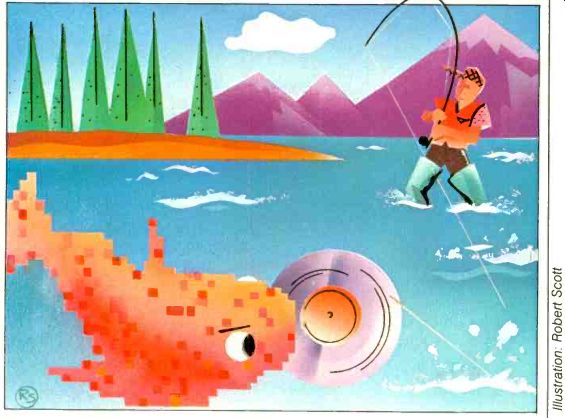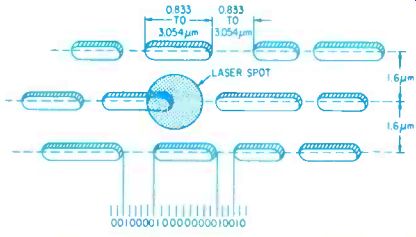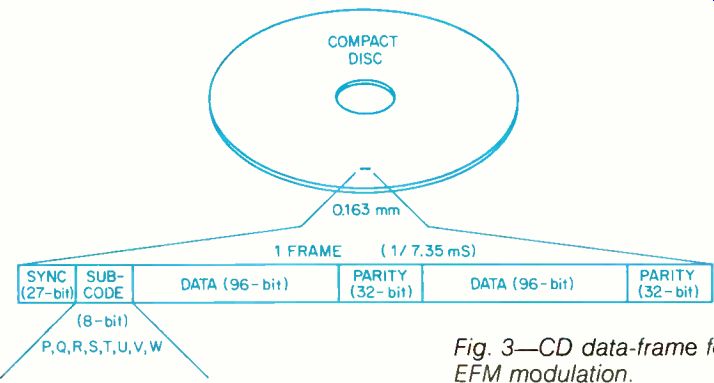FISHING THE UPSTREAM BIT

In today's digital world, everything ultimately boils down to bits. That is a comforting eventuality; all the complexity and shock of technology's advance is a little less formidable if we are able to quantize it down to some thing as graspable as the innocent bit. However, that simplicity and confidence is perhaps a little deceptive. Anyone who has ever purchased "compatible" software only to have their computer stop dead in its data tracks has learned the first lesson of digital information: A bit is a bit, but data, and informed data, is a completely different story.
Specifically, the format in which data is configured is critically important in the recovery of encoded information. Furthermore, there are many ways of formatting data, some more efficient than others. Digital storage is not a question of ones and zeros. Rather, it is a question of formatting, interleaving, modulation, and bit rate. Lately in this column we've examined the hard ware designed to read data from the Compact Disc. Now let's jump into the bit stream with a look at how data is encoded on the disc itself, that is, the upstream part of the coding. Next month we'll cast a line downstream and look at decoding.
The CD is by now a familiar method of storage. Its physical characteristics are obvious to anyone with a ruler: Disc diameter is 120 mm, hole diameter is 15 mm, thickness is 1.2 mm. A little less obvious are the physical de tails of data storage: Track pitch is 1.6 1.torn, pit width is 0.5 µm, pit (and reflective land) length varies incrementally from 0.833 to 3.054 um, with nine different pit and land lengths. It is combi- nations of those varying dimensions which physically encode the data.
Not obvious at all is the origin of the bit stream, in other words, the format by which data is ordered on the disc. For example, the pits and intervening reflective land on the CD surface do not directly designate ones and zeros. Rather, each pit edge, whether leading or trailing, is a one; everything in be tween, whether inside or outside a pit, is a zero. This is a much more efficient storage technique than coding the bi nary bits directly with pits. The technique is illustrated in Fig. 1; as you can see, rather than encode each binary bit with a pit, only four pits are needed to code many bits of information, thus saving valuable disc space and permitting longer playing time.
But even those channel bits coded by the pits are not directly commensurable to audio data. The pits on a Compact Disc are merely the end result of an elaborate data transformation which takes place during master encoding and which undergoes decoding each time the disc is played. A block diagram for encoding is shown in Fig. 2; the data begins, of course, as music.
Analog recordings must be converted to digital form with low-pass filtering, sample-and-hold, and A/D conversion circuits. Music already recorded with PCM (pulse code modulation) is directly time-multiplexed to merge the two stereo channels into one bit stream, with 44.1-kHz sampling and 16-bit quantization, recorded on a VCR via the Sony PCM-1610 digital audio processor. Once the audio data adheres to these basic specifications, it must undergo error-correction encoding and a process called eight-to-fourteen modulation (EFM), which I'll describe shortly; subcode and synchronization words must be added as well. Clearly, a data format is needed.

Fig. 1--CD surface pits and intervening lands. Pit and land lengths
vary incrementally; pit edges always represent binary "1" and intervening
spaces, binary "0."

Fig. 2--Block diagram, Compact Disc master-encoding process.

Fig. 3--CD data-frame format prior to EFM modulation.
All data on a CD is delineated by frames; by definition a frame is the smallest complete section of recognizable data on a disc. The frame provides a means to distinguish between audio data and its parity, the synchronization word, and the subcode; frame construction prior to EFM modulation is shown in Fig. 3. During the encoding process of CD mastering, all of the above data is placed into the frame format. The end result of encoding and modulation is a bit stream of frames, each frame consisting of 588 channel bits. It is the channel bits themselves that are physically cut into the disc such that each pit edge represents a bi nary one and flat areas are binary zeros.
Compact Disc frames are assembled when the master disc is cut by a laser cutter, a piece of hardware costing a cool $1.5 million. Using data from the VCR master tape, six 32-bit PCM audio sampling periods (alternately from left and right channels) are grouped in a frame. The 32-bit sampling periods are divided to yield four, eight-bit audio symbols. To scatter possible errors, the symbols from different frames are interleaved so that the audio signals in one frame originate from different frames. Interleaving might be thought of as shuffling a deck of cards; data symbols are redistributed in the bit stream. An error occurring in the medium (such as a dust particle on the disc) might prevent the successful reading of a number of symbols. However, upon de-interleaving, the shuffled symbols are placed back in their original and rightful positions in the stream. The errors are scattered in time and thus isolated, making them much easier to correct. As an addition al error-control measure, eight parity symbols are generated per frame; parity is essentially redundant data used to check for errors. The interleaving and generation of parity bits constitute the error-correction encoding based on the Cross Interleave Reed-Solomon Code (CIRC). With this encoding algorithm, bits from the audio signal are delayed and interleaved in the bit stream, and two encoding stages generate parity symbols.
An eight-bit, user-subcode symbol is added to each frame; two of these subcode bits (P and Q) contain information such as total number of selections on the disc, their beginning and ending points and playing time, index points within a selection, and program lead-in and lead-out points. The other six bits (R, S, T, U, V, and W) are available for other applications such as encoding video information on audio CDs. One still video picture could be drawn from every 20,000 to 30,000 frames; a CD holding an hour of audio data could additionally hold up to 700 still video images, drawing a new picture from the disc about every 5S. Obviously, the single bits in each frame cannot convey this information; instead, the player stores the bits from individual frames until it has accumulated enough data.
After the audio, parity and subcode data is assembled, the bit stream is modulated using the aforementioned EFM. Blocks of eight bits are translated into blocks of 14 bits using a dictionary which assigns an arbitrary and unambiguous word of 14 bits to each eight-bit word. Blocks of 14 bits are linked by three merging bits (to prevent the possibility of successive ones); thus, the ratio of bits before and after modulation is 8:17. The resultant channel stream produces pits and lands which are at least three channel bits, and no more than 11 channel bits long. We have thus defined the physical relationship of the pit dimensions. With EFM there are more bits to accommodate, but EFM also decreases the number of signal transitions (pit-to-land and land-to-pit). This lowers the laser-optical system's frequency response requirements, permitting lower track velocities and hence longer playing times.
The resulting EFM bit stream must be delineated. Therefore, a synchronization pattern is added prior to each frame. The synchronization word is uniquely identifiable from any other possible data configuration (specifically, the 24-bit synchronization word is 100000000001000000000010, plus three merging bits). When the data manipulation is completed, the original audio bit rate of 1.41 million bits per second has been augmented to 4.32 million bits per second; such is the price of overhead. That resulting bit stream is encoded onto the disc as channel bits in the form of pits and lands. To reproduce the data stored on a disc, a player must read the channel bits, decode them, and deliver an analog signal to its output jacks.
The Compact Disc bit stream is thus more complex than one might suspect. In the interests of data density and robustness, the audio signal must undergo some sophisticated processing. EFM and CIRC, as well as the entire frame structure used to delineate data, require that the data be uniquely pack aged before it is encoded onto the Compact Disc. And, of course, the player is left with the job of deciphering it all. But we'll hook our line into that topic next month.
(adapted from Audio magazine, May 1985; KEN POHLMANN )
= = = =